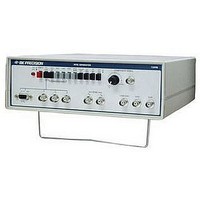1249B B&K Precision, 1249B Datasheet - Page 12

1249B
Manufacturer Part Number
1249B
Description
COLOR GENERATORNTSC/RGB
Manufacturer
B&K Precision
Type
NTSC Benchtopr
Specifications of 1249B
Patterns
Bar, Dot, Crosshatch, Raster
Connection Method
RCA, RF, S-Video
Power Source
105,130VAC
Signal Generator Type
NTSC Pattern
Supply Voltage Range
105V To 130V
External Height
86mm
External Width
290mm
External Depth
264mm
Frequency
30 Hz
Equipment Type
NTSC Pattern Generators
Lead Free Status / RoHS Status
na
Lead Free Status / RoHS Status
na
Other names
BK1249B
THE NTSC COLOR VIDEO SIGNAL (CONT.)
horizontal sync pulse at the -40 IEEE units level. An explanation
of IEEE units follows in the "Amplitude" paragraph. When the
horizontal sync pulse is detected in a television receiver, it
initiates flyback, which ends the horizontal scan and rapidly
resets the horizontal deflection circuit for the next line of
horizontal scan. The horizontal sync pulse is followed by a 4.79
microsecond back porch at the blanking level. When a color
signal is being generated, 8 to 10 cycles of 3.579545MHz color
burst occur during the back porch. The color burst signal is at a
specific reference phase. In a color television receiver, the color
oscillator is phase locked to the color burst reference phase before
starting each horizontal line of video display. When a
monochrome signal is being generated, there is no color burst
during the back porch.
VERTICAL SYNC (Refer to Fig. 2)
frame. A frame consists of two interlaced vertical fields of 262.5
lines each. The image is scanned twice at a 60Hz rate (59.94Hz to
be more precise), and the lines of Field 2 are offset to fall
between the lines of Field 1 (interlaced) to create a frame of 525
lines at a 30Hz repetition rate.
horizontal lines is used for the vertical blanking interval. In a
television receiver, the vertical blanking interval prevents
illumination of the CRT during the vertical retrace. The vertical
sync pulse, which is within the vertical blanking interval, initiates
reset of the vertical deflection circuit so the electron beam will
return to the top of the screen before video scan resumes. The
vertical blanking
A complete video image as seen on a TV screen is called a
At the beginning of each vertical field, a period equal to several
12
interval begins with the first equalizing pulse, which consists of
six pulses one half the width of horizontal sync pulses, but at
twice the repetition rate. The equalizing pulse has an 8% duty
cycle. The vertical sync pulse occurs immediately after the fast
equalizing pulse. The vertical sync pulse is an inverted
equalizing pulse at 92% duty cycle. The wide portion of the
pulse is at the -40 IEEE units level and the narrow portion of the
pulse at the blanking level. A second equalizing pulse at 8%
duty cycle occurs after the vertical sync pulse, which is then
followed by 13 lines of blanking level (no video) and
horizontal sync pulses to assure adequate vertical retrace time
before resuming video scan. The color burst signal is present
after the second equalizing pulse.
while in Field 2 line 260 contains only a half line of video. This
timing relationship produces the interlace of Fields l and 2. The
NTSC color bars pattern generated by this instrument is
interlaced per NTSC standards.
AMPLITUDE (Refer to Fig. 1)
peak, from the tip of a sync pulse to 100% white. This 1 volt
peak-to-peak signal is divided into 140 equal parts called IEEE
units. The zero reference level for this signal is the blanking
level. The tips of the sync pulses are at -40 units and a sync
pulse is approximately 0.3 volt peak-to-peak. The portion of
the signal that contains video information is raised to a set-up
level of +7.5 units above the blanking level. A monochrome
video signal at +7.5 units is at the black threshold. At +100 units
the signal represents 100%
Note that in Field 1, line 522 includes a full line of video,
A standard NTSC composite video signal is 1 volt peak-to-










